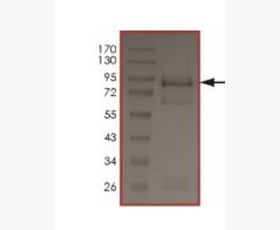Recombinant Human Caspase-10/CASP10
| Product name: | Recombinant Human Caspase-10/CASP10 |
| Source: | E. coli |
| Purity: | Greater than 95% as determined by reducing SDS-PAGE. |
| Buffer Formulation: | Supplied as a 0.2 μm filtered solution of 25mM HEPES, 10mM DTT, pH 7.5. |
| Applications: | Applications:SDS-PAGE; WB; ELISA; IP. |
| Storage: | Avoid repeated freeze/thaw cycles. Store at 2-8 oC for one month. Aliquot and store at -80 oC for 12 months. |
| UOM: | 100ug/50ug/200ug/1mg/1g |
| Source | E. coli |
| Description | Recombinant Human Caspase-10 is produced by our E.coli expression system and the target gene encoding Val220-Ile480 is expressed with a 6His tag at the C-terminus. |
| Names | Caspase-10, CASP-10, Apoptotic Protease Mch-4, FAS-Associated Death Domain Protein Interleukin-1B-Converting Enzyme 2, FLICE2, ICE-Like Apoptotic Protease 4, CASP10, MCH4 |
| Accession # | Q92851-2 |
| Formulation | Supplied as a 0.2 μm filtered solution of 25mM HEPES, 10mM DTT, pH 7.5. |
| Shipping |
The product is shipped on dry ice/ice packs. |
| Storage |
Store at < -20°C, stable for 6 months after receipt. Please minimize freeze-thaw cycles. |
| Purity |
Greater than 95% as determined by reducing SDS-PAGE. |
| Endotoxin | Less than 0.1 ng/µg (1 IEU/µg) as determined by LAL test. |
| Amino Acid Sequence |
MVKTFLEALPQESWQNKHAGSNGNRATNGAPSLVSRGMQGASANTLNSETSTKRAAVYRMNRNHR GLCVIVNNHSFTSLKDRQGTHKDAEILSHVFQWLGFTVHIHNNVTKVEMEMVLQKQKCNPAHADG DCFVFCILTHGRFGAVYSSDEALIPIREIMSHFTALQCPRLAEKPKLFFIQACQGEEIQPSVSIE ADALNPEQAPTSLQDSIPAEADFLLGLATVPGYVSFRHVEEGSWYIQSLCNHLKKLVPRHEDILS ILEHHHHHH
|
| Background | Caspase-10 (CASP10) is a 521 amino acid protein member of the Cysteine-Aspartic Acid Protease (Caspase) family. CASP10 contains two DED (Death Effector) domains and is detectable in most tissues. CASP10 cleavage by Granzyme B and autocatalytic activity generate the two active subunits: Caspase-10 subunit p23/17, Caspase-10 subunit p12. Caspases are a family of cytosolic aspartate-specific cysteine proteases involved in the execution-phase of cell apoptosis, the initiation and execution. Human caspases can be subdivided into three functional groups: cytokine activation (caspase-1, -4, -5, and -13), apoptosis initiation (caspase-2, -8, -9, -and -10), and apoptosis execution (caspase-3, -6, and -7). CASP10 cleaves and activates caspases 3 and 7, but itself is processed by caspase 8. Defects in CASP10 are associated with apoptosis defects seen in type II autoimmune lymphoproliferative syndrome. |














